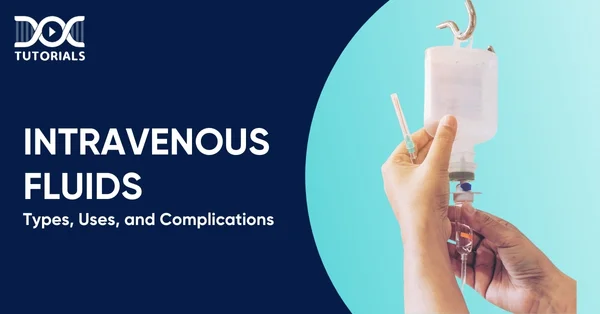Intravenous Fluids: Types, Uses, and Complications

Intravenous (IV) fluids are a cornerstone of contemporary medical care, given to patients for hydration, electrolyte balance, medication administration, and nutritional supplementation. From the emergency room to the operating room, IV fluids are essential in stabilising the patient.
Knowing the different types of IV fluids, their compositions, uses, and side effects is fundamental for safe and competent clinical practice. Besides, young medical students studying for the NEET PG exam need to be acquainted with these medical practices.
To help them out, DocTutorials provides well-framed resources and visual aids—like the IV fluids types chart—to simplify these complex topics and enhance exam readiness.
What is IV Fluid?
Intravenous (IV) fluids are sterile fluid solutions infused directly into a vein via a thin tube known as an IV line. They are used to alleviate dehydration, normalise electrolyte imbalances, administer medications, or supply necessary nutrients quickly and efficiently.
IV therapy enables fluids to be introduced into the circulatory system instantly, providing quicker and more controlled treatment than oral ingestion. These fluids are precisely controlled in terms of type, dose, and rate to provide safe and effective patient care.
What are the Different Types of Intravenous Fluids?
There are various categories of intravenous fluids, each having particular medical uses. They are generally distinguished as crystalloids and colloids based on the molecular size they hold and how they function in the body. Here are the types of intravenous fluids:
- Crystalloid Solutions
Crystalloid solutions are the most routinely used category of IV fluids. They have dissolved particles that are small in size and can conveniently pass from the blood into tissues and nearby cells. These are subdivided into several types that include:
- Normal Saline (0.9% NaCl)
One of the most commonly used crystalloid solutions is Normal Saline (0.9% NaCl), which is isotonic and used to support fluid volume. It is used for routine hydration, the treatment of shock, haemorrhage, and blood transfusions. Excess sodium will retain fluid in patients with kidney or heart disease; caution is therefore indicated.
- Half Normal Saline (0.45% NaCl)
Half Normal Saline (0.45% NaCl) is a hypotonic solution that rehydrates cells by permitting water to flow into them. It is usually used in mild dehydration and diabetic ketoacidosis. However, it should not be used in patients with burns, liver disease, or trauma since it decreases the intravascular fluid volume and aggravates the condition.
- Lactated Ringer’s Solution
This is also a crystalloid solution quite similar to the composition of plasma. It includes sodium, chloride, potassium, calcium, and lactate and is particularly beneficial for electrolyte replenishment and correction of pH.
It is generally used in burn cases, surgical recovery, and gastrointestinal loss of fluid. Patients with liver disorders or renal failure must stay away from it because it contains potassium, and its metabolism relies on the liver.
- Dextrose Solutions
These solutions, such as D5W (5% dextrose in water), provide hydration and a supply of glucose, yielding body energy. These solutions may be mixed with saline or other fluids to enhance efficacy.
They are used when low blood sugar dehydration occurs or as a vehicle for intravenous medication. However, dextrose-based solutions are not suitable for long-term nutrition and must be avoided in patients at risk of fluid overload, such as those with heart or kidney conditions.
- Colloid Solutions
Colloid solutions have bigger molecules that cannot be easily filtered out of blood vessel walls. They remain in the bloodstream for a longer time and are good at increasing blood volume. These solutions are classified into different subtypes:
- Albumin
Albumin is a colloid derived naturally from protein that increases plasma volume. It is used to treat conditions such as hypoalbuminaemia, extensive burns, and major surgery. However, it can be costly and sometimes cause allergic reactions.
- Hetastarch (HES)
Hetastarch (HES) is a colloidal solution that mimics albumin in holding fluid in the blood vessels. It is used in volume resuscitation in extreme blood loss or shock. However, the drug’s use is limited by possible side effects, such as renal impairment and bleeding complications in critically ill patients.
What are the Common Uses of Intravenous Fluids?
IV solutions are administered in different clinical situations to rapidly replenish and sustain the body’s fluid, electrolyte, and nutritional levels. The following are the most frequent applications of IV therapy:
- Treats severe dehydration due to illness, heat exhaustion, or fluid loss due to vomiting and diarrhoea.
- Administers drugs intravenously for more effective and faster treatment.
- Manages pain by injecting IV pain medication or following surgery.
- Replaces lost blood during trauma, surgery, or internal bleeding through blood transfusions.
- Supplies nutrition to malnourished patients through IV nutrition (parenteral nutrition).
- It supports fluid balance in surgeries during and after which oral intake is not feasible.
- Stabilises patients with burns, injury, or critical illness by replenishing fluids and electrolytes rapidly.
IV fluids are essential in emergency medicine, surgery, and long-term care. They provide quick and controlled therapy specifically tailored to each patient’s unique needs.
What are the Complications Associated with Intravenous Fluids?
Although IV therapy is very common and, in general, safe, it may, on rare occasions, cause complications, particularly when prolonged. Knowing these complications ensures rapid identification and management:
- Damage to the vein or blood vessel may result from needle insertion or when the IV is left in position for too long, with possible pain or swelling.
- Phlebitis, which is vein inflammation, can occur as a result of extended IV use, leading to redness, pain, and warmth at the site.
- Minor side effects like bleeding and bruising at the site of insertion are usual for patients with bleeding disorders or fragile veins.
- Infiltration is when IV fluid seeps into adjacent tissue through a dislodged needle and causes stinging, swelling, or pain in a small area.
- Haematoma results from leaking blood into surrounding tissues, which creates a bruise visible below the surface that heals in weeks.
- Fluid overload can result if excessive fluid is given too rapidly and causes symptoms of headache, hypertension, and shortness of breath.
- Air embolism is a less common but potentially severe complication wherein air is introduced into the vein via the IV line and can cause fatal consequences.
- Pitting veins can occur with insertion or prolonged IV use, necessitating a change to another vein for ongoing therapy.
- Cellulitis and skin necrosis are more serious infections or tissue destruction that could occur in unusual circumstances if IV therapy is mishandled.
- Local infection of the site of insertion can occur if the site is not kept sterile, but can typically be resolved effectively with antibiotics.
- Local irritation or, less frequently, systemic reactions may occur due to allergic responses to adhesives or parts of the IV equipment.
FAQs About Intravenous Fluids
- What are the advantages of IV therapy in hospitals?
IV therapy also allows for the immediate introduction of fluids, medication and nutritional supplements into the blood, which is optimal in emergencies when a patient has severe dehydration from excessive vomiting, diarrhoea, or some kind of electrolyte loss.
- Can someone get IV therapy at home?
Even if there are services providing IV vitamin therapy in your home, you should always check and consult a healthcare professional before undergoing such therapy. Precisely, home-based IV therapy has many potential risks, such as infections or complications related to IV administration.
- How long do the IV fluids stay in the human body?
IV fluids begin to work right away because they directly enter the bloodstream. However, how long they remain in the human body is based on the individual’s unique metabolism, their hydration needs, and the type of fluid administered.
- Who needs IV fluids?
IV fluids are usually necessary when the digestive system is not functioning well or when certain conditions require a patient to get more fluids than they can take by mouth, such as blood component transfusions, medications that cannot be taken orally, or other medical treatments.
- What types of IV drips are used in hospitals?
In a hospital environment, intravenous (IV) fluids are classified as isotonic, hypotonic, or hypertonic depending on their concentration of solute compared to blood.
Conclusion
Intravenous fluids are a pillar of patient care, and knowing their types, applications, and complications is essential for each medical practitioner. From rehydrating to stabilising shock, IV therapy saves lives if appropriately applied.
Supported by educational resources such as the IV fluids types chart and organised learning material from DocTutorials, students are better able to comprehend such intricate concepts and improve their NEET PG preparation. Master intravenous fluids today—with confidence, clarity, and the right guidance from DocTutorials.Join our NEET PG courses today!
Latest Blogs
-

NEET SS Exam 2024: Analysis, Key Dates, Counselling
The NEET SS 2024 exam kicked off on March 29, 2025. Over two days and two slots, candidates across 13…
-

NEET PG Registration 2025: An Essential Guide For Exam Prep
The NEET PG registration, which is conducted online, is a crucial step in the exam process. Filling out the NEET…
-

NEET PG Syllabus 2026: A Must-Have Complete Guide for Exam Success
The NEET PG Syllabus acts as one of the foundation stones for aspiring postgraduate medical students like you who are…




